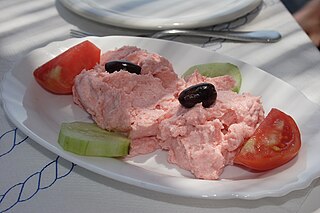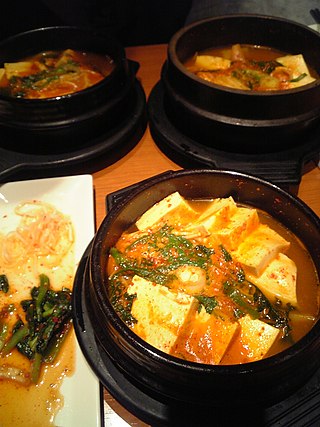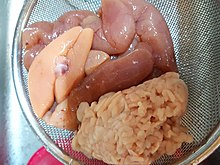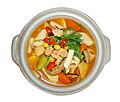
Onigiri, also known as omusubi (お結び), nigirimeshi (握り飯), or rice ball, is a Japanese food made from white rice formed into triangular or cylindrical shapes and often wrapped in nori. Traditionally, an onigiri is filled with pickled ume (umeboshi), salted salmon, katsuobushi, kombu, tarako, mentaiko, takanazuke or any other salty or sour ingredient as a natural preservative. Because it is easily portable and eaten by hand, onigiri has been used as portable food or bento from ancient times to the present day. Originally, it was used as a way to use and store left-over rice, but it later became a regular meal. Many Japanese convenience stores and supermarkets stock their onigiri with various fillings and flavors. It has become so mainstream that it is even served in izakayas and sit-down restaurants. There are even specialized shops which only sell onigiri to take out. Due to the popularity of this trend in Japan, onigiri has become a popular staple in Japanese restaurants worldwide.

Roe, or hard roe, is the fully ripe internal egg masses in the ovaries, or the released external egg masses, of fish and certain marine animals such as shrimp, scallop, sea urchins and squid. As a seafood, roe is used both as a cooked ingredient in many dishes, and as a raw ingredient for delicacies such as caviar.

Taramasalata or taramosalata is a meze made from tarama, the salted and cured roe of the cod, carp, or grey mullet (bottarga) mixed with olive oil, lemon juice, and a starchy base of bread or potatoes, or sometimes almonds. Variants may include garlic, spring onions, or peppers, or vinegar instead of lemon juice. While not traditionally Greek, smoked rather than cured cod's roe is more widely available in some places, and often used. Bottarga is usually much more expensive than cod's roe.

Milt is the seminal fluid of fish, mollusks, and certain other water-dwelling animals which reproduce by spraying this fluid, which contains the sperm, onto roe. It can also refer to the sperm sacs or testes that contain the semen.

Jjigae are Korean stews. There are many varieties; they are typically made with meat, seafood or vegetables in a broth seasoned with gochujang, doenjang, ganjang or saeu-jeot. Jjigae is often served as a communal dish.

Fresh fish rapidly deteriorates unless some way can be found to preserve it. Drying is a method of food preservation that works by removing water from the food, which inhibits the growth of microorganisms. Open air drying using sun and wind has been practiced since ancient times to preserve food. Water is usually removed by evaporation but, in the case of freeze-drying, food is first frozen and then the water is removed by sublimation. Bacteria, yeasts and molds need the water in the food to grow, and drying effectively prevents them from surviving in the food.

In Japan, it is customary to serve alcoholic drinks with snacks called sakana, shukō, or otsumami (お摘み). These are usually quite salty and served in relatively small portions. Sakana are usually more substantial than tapas, although they are not considered a meal since they are not accompanied by rice. Traditionally, the Japanese regarded sake, which is made from rice, as a substitute for white rice served in a standard Japanese meal, and as a result some Japanese do not eat rice and drink alcohol simultaneously.

The Alaska pollock or walleye pollock is a marine fish species of the cod genus Gadus and family Gadidae.

Many cuisines feature eggplant salads and appetizers.

Gyeran-jjim (Korean: 계란찜), Dalgyal-jjim (달걀찜) or steamed eggs is a type of jjim, Korean steamed dish. It is a custardy, casserole-like banchan, often seasoned with saeu-jeot or myeongnan-jeot and topped with scallions and toasted sesame seeds. The ideal gyeran-jjim is light and fluffy.

Cod and other cod-like fish have been widely used as food through history. Other cod-like fish come from the same family (Gadidae) that cod belong to, such as haddock, pollock, and whiting.

Red caviar is a caviar made from the roe of salmonid fishes, which has an intense reddish hue. It is distinct from black caviar, which is made from the roe of sturgeon.

Alaska pollock, a species of cod (Gadus) found in the North Pacific ocean, is used as food globally. Compared with common pollock, Alaska pollock is milder in taste, whiter in color, and lower in oil content.

Gyeran-mari, dalgyal-mari (달걀말이) or rolled omelette is a dish in Korean cuisine. It is a savory banchan made with beaten eggs mixed with several finely diced ingredients, then progressively fried and rolled. Common ingredients include vegetables, mushroom, processed meat, salt or salted seafood, and cheese. Optionally, gim (seaweed) is folded with the omelette. When served, the omelette is cut into 2–3 centimetres (0.79–1.18 in) slices. It is also a common anju found at pojangmacha.

Baechu-kimchi (배추김치), translated as napa cabbage kimchi or simply kimchi is a quintessential banchan in Korean cuisine, made with salted, seasoned, and fermented napa cabbages.

Ojingeo-jeot (오징어젓) or salted squid is a jeotgal made by salting and fermenting thinly sliced squid. It is a popular banchan with high protein, vitamin and mineral contents.

































